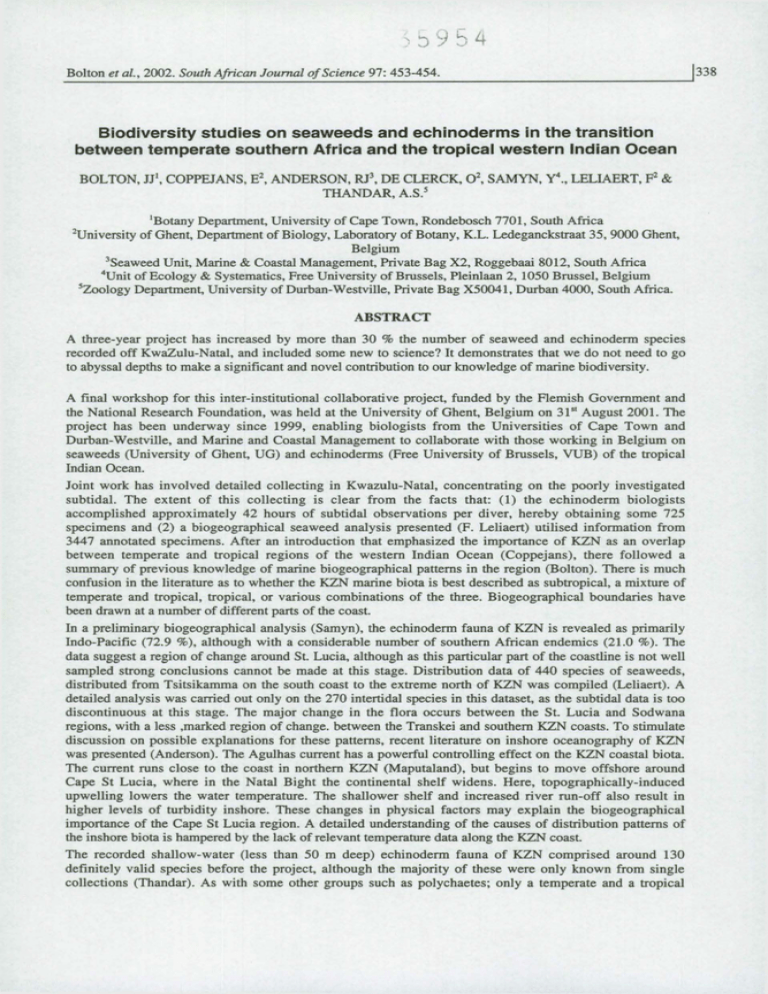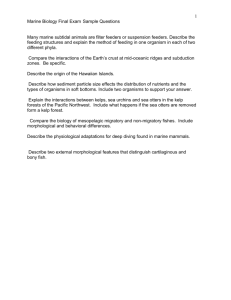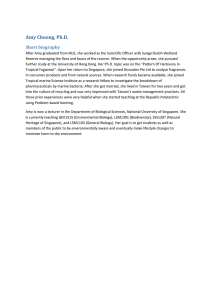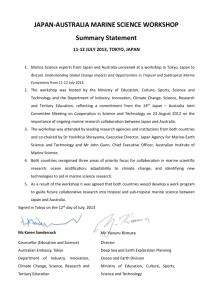Biodiversity studies on seaweeds and echinoderms in the transition
advertisement

Bolton et al., 2002. South African Joumal of Science 97: 453-454. j338 ------~--------~--------~------------------------------------~ Biodiversity studies on seaweeds and echinoderms in the transition between temperate southern Africa and the tropical western lndian Ocean BOLTON, JJ 1, COPPEJANS, E2, ANDERSON, RJ3, DE CLERCK, 0 2, SAMYN, Y\ LELIAERT, F2 & THANDAR, A.S. 5 2 1 Botany Department, University of Cape Town, Rondebosch 7701, South Africa University of Ghent, Department of Biology, Laboratory of Botany, K.L. Ledeganckstraat 35, 9000 Ghent, Belgium 3 Seaweed Unit, Marine & Coastal Management, Private Bag X2, Roggebaai 8012, South Africa •unit ofEcology & Systematics, Free University of Brussels, Pleinlaan 2, 1050 Brussel, Belgium 5 Zoology Department, University ofDurban-Westville, Private Bag X50041, Durban 4000, South Africa. ABSTRACT A three-year project bas increased by more than 30 % the number of seaweed and echinoderm species recorded off KwaZulu-Natal, and included some new to science? It demonstrales that we do not need to go to abyssal deptbs to make a significant and novel contri bution to our knowledge of marine biodiversity. A final workshop for this inter-institutional collaborative project, funded by the Flernish Government and the National Research Foundation, was held at the University of Ghent, Belgium on 31" August 2001. The project bas been underway since 1999, enabling biologists from the Universities of Cape Town and Durban-Westville, and Marine and Coastal Management to collaborale with those workingin Belgium on seaweeds (University of Ghent, UG) and echinoderms (Pree University of Brussels, VUB) of the tropical Indian Ocean. Joint work bas involved detailed collecting in Kwazulu-Natal, concentrating on the poorly investigated subtidal. The extent of this colleering is clear from the facts that: (1) the echinoderm biologists accomplished approximately 42 hours of subtidal observations per diver, hereby obtaining some 725 specimens and (2) a biogeographical seaweed analysis presented (F. Leliaert) utilised information from 3447 annotated specimens. After an introduetion that emphasized the importance of K.ZN as an overlap between temperate and tropical regions of the western Indian Ocean (Coppejans), there foliowed a summary of previous knowledge of marine biogeographical patterns in the region (Bolton). There is much confusion in the literature as to whether the K.ZN marine biota is best described as subtropical, a mixture of temperate and tropical, tropical, or various combinations of the three. Biogeographical boundaries have been drawn at a number of different parts of the coast. In a prelirninary biogeographical analysis (Samyn), the echinoderrn fauna of K.ZN is revealed as primarily Indo-Pacific (72.9 %), although with a considerable number of southern African endemies (21.0 %). The data suggest a region of change around St. Lucia, although as this particular part of the coastline is not well sampled strong conclusions cannot be made at this stage. Distribution data of 440 species of seaweeds, distributed from Tsitsikarnma on the south coast to the extreme north of K.ZN was compiled (Leliaert). A detailed analysis was carried out only on the 270 intertidal species in this dataset, as the subtidal data is too discontinuous at this stage. The major change in the flora occurs between the St. Lucia and Sodwana regions, with a less ,marked region of change. between the Transkei and southern K.ZN coasts. To stimulate discussion on possible explanations for these patterns, recent literature on inshore oceanography of K.ZN was presented (Anderson). The Agulhas current has a powerful controlling effect on the K.ZN coastal biota. The current runs close to the coast in northern K.ZN (Maputaland), but begins to move offshore around Cape St Lucia, where in the Natal Bight the contioental shelf widens. Here, topographically-induced upwelling lowers the water temperature. The shallower shelf and increased river run-off also result in higher levels of turbidity inshore. These changes in physical factors may explain the biogeographical importance of the Cape St Lucia region. A detailed understanding of the causes of distri bution patterns of the inshore biota is hampered by the Jack of relevant temperature data along the K.ZN coast. The recorded shallow-water (less than 50 m deep) echinoderm fauna of KZN comprised around 130 definitely valid species before the project, although the majority of these were only known from single collections (Thandar). As with some other groups such as polychaetes; only a temperare and a tropical biogeographical region have been recognized, with a boundary along the Transkei coast. In the course of the project 51 species have been added to the echinoderm fauna of the region, an increase of almost 30% (Samyn). Most of the additions belong to the tropical Indo-West-Pacific component, although they include at least three species of seacucumber and presumably one species of brittlestar new to science. It is also noteworthy that several genera belonging to different echinoderm classes are here reported for the first time for southern Africa. In this respect, some of the new findings in the family Holothuriidae (Holothuroidea: Aspidochirotida) are bearing the palm. For instance, the genus Labidodemas which comprised up till now only four species was hithertho unknown from southern Africa, while in the course of this project two known species and one new species to science have been reported, allowing a worldwide revision of the genus. Similar efforts are undertaken for the holothurian genera Actinopyga and Holothuria and for the genus Ophiocoma (Ophiuroidea: Ophiocomidae). The recorded flora of red algae (Rhodophyta) for KZN has been similarly increased by 30%, from 221 to 289 species (De Clerck). Among the 68 new records, the majority are again Indo-West-Pacific tropical species, with a few pan-tropical species. A few species have disjunct distributions in the Indian Ocean, and these tend to be deeper subtidal species, suggesting that the gaps are due to insufficient collections. New records of species described from Australia are not uncommon, but there are very few species which appear to be endemic to northern KZN/southern Mozambique. A new genus of the red algal family Ceramiaceae will be submitted for publication; based on these collections (De Clerck). Detailed studies of the taxonomy of certain red algal groups were presented, including Plocamium (Engledow, UG), and molecular systematic studies on the Gelidiaceae (Tronchin, UCT) and the Gracilariaceae (Iyer, UCT). A number of new species and new records will eventually be published from these studies: For the green algae (Chlorophyta; Leliaert), 23 of the species found were new records for KZN (38% increase), including 17 new records for South Africa. The flora now includes 11 species of Cladophora (previously 3), and 11 species of Caulerpa. A further presentation introduced the Flanders Marine Data and Information Centre (Vanden Berghe, Flanders Marine Institute) who will contribute GIS and other expertise to a proposed extension of the current project. A clear understanding of biogeographical boundaries is necessary to investigate potential effects of global wanning; and further studies are planned to concentrate on the Cape St Lucia marine boundary. These would include the documenting the inshore temperature regime at a number of sites, describing the subtidal marine vegetation and the echinoderm biodiversity in this overlap, as well as producing guides to the seaweeds and echinoderms of Kwazulu-Natal. We are greatful to Drs Jean Harris and B. Elliot and their colleagues at KZN Wildlife, for their invaluable logistical support.







